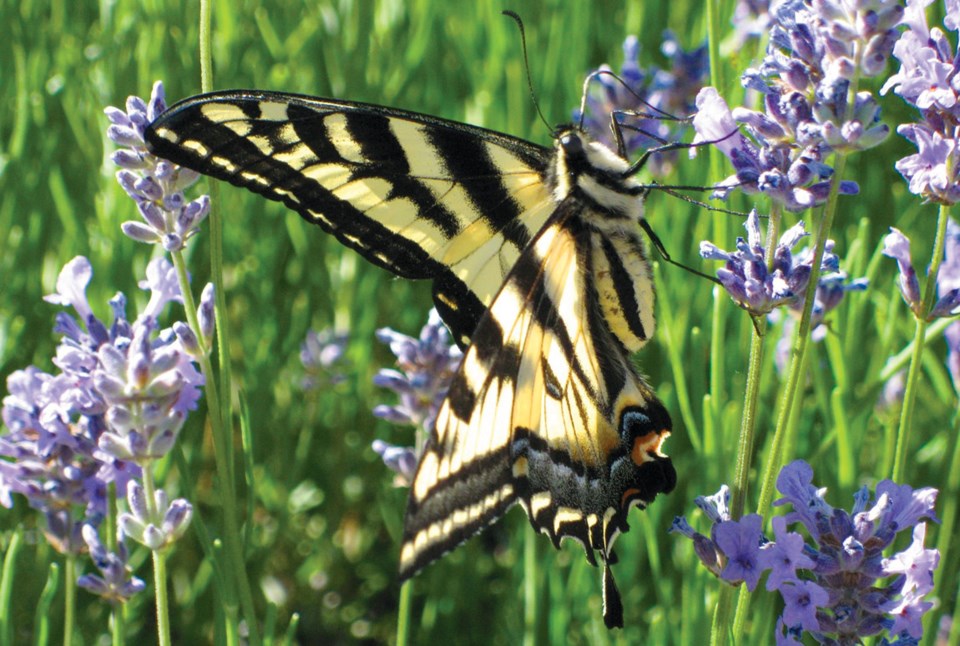With the dry, hot weather upon us lavender is showing its best features.
An evergreen sub-shrub in the mint family, it is a great plant for a well-drained sunny location. It is used as an ornamental, a culinary and medicinal herb and for oil extraction.
A flower accidentally dropped into my cup yesterday and it was a wonderful addition to the strawberry lemonade tea I was drinking. That same evening, I harvested blooms to dry to use for tea and to add into my vegan chocolates.
There are four types grown commonly here on the coast. Lavendula angustifolia (English lavender) is probably the most popular type. It is a compact shrub, 45-60 centimetres tall, with the flowers held quite close to the shrub. This lavender is most valued for its high-quality oil, and hence has a wonderful fragrance. There are many cultivars, mostly with mauve and purple flowers. Two of the common ones are munstead and my favourite Hidecote blue.
Lavandula x Intermedia (French lavender, Lavandin) is a popular plant for commercial production thanks to its high yields. These plants can vary greatly in size and colour, from compact, white flowers to tall purple varieties, and everything in between. Notable for their long flower stalks, they are very popular for dried bouquets. The flowering times vary and can provide blooms from early July to late August.
Lavandula stoechas (Spanish lavender) is less hardy than the other types we commonly grow here, and did not fare well during our long cold winter. Growing 30-100 centimetres tall, each flower spike has several sterile bracts at the top and grey-green leaves. This one will keep flowering throughout the summer if deadheaded. It is used commercially and its smell is less sweet than L. angustifolia and L. x Intermedia. It has a more medicinal smell and is used in insecticides, air fresheners, disinfectants and deodorants. This plant has been declared invasive in Australia and parts of Spain.
Lavandula dentata (also referred to as French lavender) have a grey-green tomentose (wooly) foliage, and the leaves are serrated. It grows from 60 to 90 centimetres. This is a tender plant, and will only survive outside in milder areas like ours.
One of my most memorable trips to Vancouver Island started with an impromptu visit to Victoria Lavender farm close to the ferry terminal in Sidney, B.C. I was lucky enough to encounter the owner doing his chores and had an extensive tour of his fields, learning about the growing practices involved in commercial lavender farming. The sales area was full of enticing items to look at, eat, smell and enjoy.
Lavender has had many uses throughout the ages, and is classified as aromatic, carminative, antispasmodic, expectorant, stimulant, cosmetic, culinary, decorative, medicinal, antibacterial, and antiseptic.
Currently we see lavender used in essential oils (lavender oil is one of the few essential oils that can be applied directly to the skin), and it is particularly useful for treating rose thorn stabs and other scrapes and cuts. It can also be used as a mosquito and moth repellent.
The flowers are used in teas, baked goods, cheeses, potpourris, sachets, and scented washes. It is also used as a crop for bees to make honey from. Lavender is also used for decorating and scenting champagne, and it is candied for adding flair and flavour to food decorations. The leaves are used to flavour meat and vegetables, and for a milder tea than the flowers produce. Lavender use is not recommended during pregnancy or breast feeding.
In the landscape, it is best used in sunny, well-drained locations, and is particularly nice near walkways where the fragrance will be appreciated. It pairs beautifully with roses, and bees and butterflies love the flowers.
Heather Schamehorn is a certified residential landscape designer and consultant, educator, habitat and sustainability advocate and dog lover. perennialpleasures.ca



